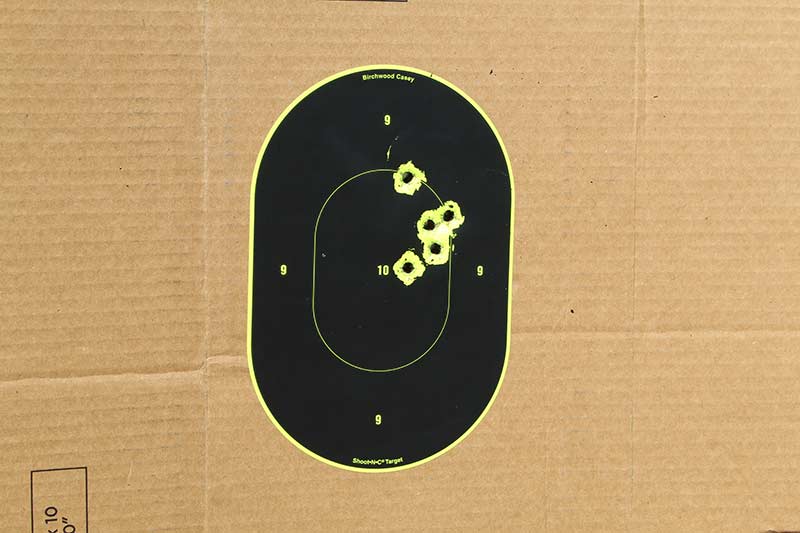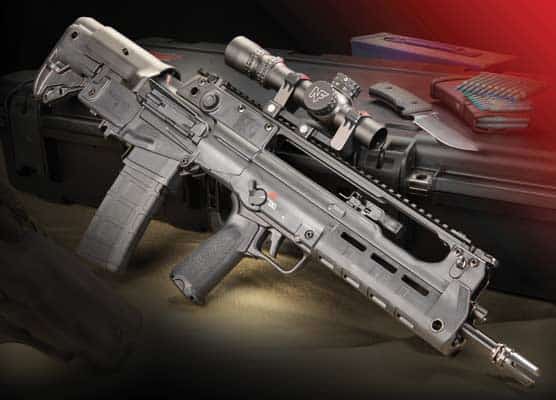Take Your Range
Dave’s Makeshift Stand Goes Literally Anywhere
About 10 bucks’ worth of PVC pipe, a couple of corner joints and two T-joints, a saw and a tape measure are all one needs to build a portable and lightweight target stand, and when I head into the High Lonesome for a break, it can go along for an impromptu shooting session.
The best part about such a setup is that it can be repaired for a few more bucks in the event a bullet goes wild and hits one of the tubes. My brother conked my first one, and last month, I managed to throw a wild shot to accomplish the same thing. A trip to the hardware store, about 20 minutes of measuring and cutting, and bingo, my target stand was back in business.
Get a 10-foot piece of 1-inch PVC, cut it into two 5-foot sections, and join everything together at the joints. Remember to NOT glue or cement them together, sections may be replaced if one is hit. Add three large clips to hold the cardboard, upon which targets are placed, and you’re in business. This thing fits right in the bed of my truck.
Now, that out of the way, this lightweight stand went along last month when I stole a few hours of a brief vacation (much of which was spent dealing with household stuff, harvesting the vegetable garden and repairing a freezer), drove over the pass to a spot I know with a good backstop and virtually no traffic on a Sunday afternoon, for a quick check of some handloads.
For years, I’ve been shooting 250-grain flat-nose lead bullets from my Ruger New Vaquero revolvers, one with a 4 5/8-inch barrel and the other with a 7 ½-incher. I use HP-38 for velocities around 800-850 fps; for several years, the Hodgdon Annual Manual listed loads for this bullet using charges of up to 7.1 grains. For reasons known only to the Annual Manual editors, data for HP-38 for this specific bullet doesn’t appear in my 2023 edition of the Annual Manual (page 162). But I checked, and it’s there in all of the previous editions, and it still works!
Hornady produces a 255-grain flat point “Cowboy” bullet, and the maximum charge of HP-38 listed in Hornady’s 8th Edition manual (page 1010) is 6.9 grains. I’ve loaded hundreds of these with excellent results.
Recently, I’ve been experimenting with Hornady’s 250-grain XTP ahead of CFE Pistol, which is one of the propellants suggested in Hodgdon’s 2023 edition of the Annual Manual (also page 162). The results are promising.
I suppose it was my experience with .45 Colt cartridges and lead pills which helped bring me around to trying hard cast LSWC projectiles in the .41 Magnum.
Back at the Elmer Keith shoot in 2022, my pal Ed Ditunno told me about molding 225-grain LWSC bullets for his .41 Magnum loads, and he sent me about 150 of these a couple of months ago. He recommended launching them with a charge of Hogdon’s H110, so I tried the combination he suggested and was delighted with the results. The accompanying photo (see below) shows a 5-shot group fired from a 4-inch Smith & Wesson Model 57 at a distance of roughly 15 yards using a solid rest and two-hand hold. My rounds went slightly high and to the right, but I’m satisfied, and a rear sight shift will solve the drift problem. As for shooting high, it’s not a problem, as I spotted a chunk of plywood someone had put near the top of the gravel pit I was using — a distance of about 60 yards — and I hit it hard enough to cause the board to fall over and slide downhill. They average about 1,000 fps, and my highest speed was 1,080 fps.
Now, an excellent reference for shooting cast lead bullets is Lyman’s Cast Bullet Handbook, 4th edition. Turning to pages 266-267, you will find load recommendations for four different bullets for the .41 Magnum ranging from 185 to 220 grains, and in all four columns, you will find suggestions for both H110 and 2400, plus several other good propellants.
As reported earlier, I’ve been experimenting for the past several months with lead SWC bullets from a variety of sources, including 200-grainers from Stateline Bullets, 215-grain pills from Rim Rock Bullets, and now Ditunno’s 225-grainers. I’ve been impressed with the results, especially in the muzzle velocity and accuracy departments. So far, leading has not become an issue, but I still use a brush and Hoppe’s No. 9 at each cleaning. Maybe it’s because I like the smell of No. 9!
NOTE: Always follow load recommendations listed in the various manuals for whatever bullet you are using. These guys know their stuff, and using loading data for specific bullets has put venison in my freezer for several years, regardless of the caliber of rifle or handgun I was using.
What’s the Point?
So, some of you might be scratching your heads, wondering about the point of this. Simply put, even casual practice is practice, and if my little essay inspires one or two folks to do this sort of shooting, maybe it’ll be a small success story.
Also, you can make a portable target stand and build it “trunk capable” by cutting the 5-foot legs in half and adding couplers on each leg so it all breaks down into a package about 30 inches long when all the parts are stuck in a tote bag.
I’ll admit to having good days on the range and some crummy ones, so every chance I get, I’ll take a little ride somewhere and bring along a couple of handguns, my portable stand, targets and ammunition. Maybe on one trek I’ll have one of my .45-caliber Colt Commanders, or my full-size 1911s. Next time out, it’ll be a .357 Magnum adventure with a Model 19 S&W and 1980s-vintage Colt Python. After that, I’ll have one or two .41 Magnums.
This kind of practice with a variety of handguns in various calibers amounts to staying familiar with all of the handguns in my safe. Such practice could come in handy one day in an emergency, and anyone who owns several sidearms in different calibers really should remain proficient with them.
By using cast bullets, I’m also saving money and being a little nicer to my barrel rifling. Having used 210-grain JHPs from Nosler (primarily), Sierra, Speer and Hornady over the past 30-plus years with no complaints — especially from the three deer I’ve put down with two different handguns— I’ve found just how much fun one can have punching little (or bigger) round holes in Birchwood Casey Shoot-N-C or traditional paper targets can be. I don’t pretend to be a consistent X-ring puncher, but I can generally put ‘em in the black.
Making it easier to enjoy impromptu shooting exercises way back in the high country (places where dusty/muddy/bumpy trails pretend to be roads) with a portable and lightweight target stand simply keeps my trigger finger tuned up.
I don’t mind sharing this “do-it-yourself (DIY)” stuff with readers because I know many of you will try it on your own. If you do, send me a note sometime via [email protected] and let me know how it goes. Just remember to pick a safe backstop before shooting.
Red Flag Challenge
For perhaps the first time, and presumably not the last, the Second Amendment Foundation late last month filed a federal lawsuit challenging a state “red flag” law.
Specifically, the target state is Maryland (where SAF and the Citizens Committee for the Right to Keep and Bear Arms are challenging the state’s ban on so-called “assault weapons” already), and SAF is joined by a private citizen, Donald S. Willey, a 64-year-old Marine Corps veteran.
The lawsuit, filed in U.S. District Court for the District of Maryland, names as defendants Maryland Attorney General Anthony G. Brown, Dorchester County, Dorchester County Planning and Zoning Director Susan E. Webb, and Dorchester County Sheriff James W. Phillips. All three officials are sued in their “official capacities,” and Webb is also being sued personally.
SAF and Willey are represented by attorneys Edward Andrew Paltzik and Serge Krimnus of the Bochner PLLC law firm in New York City.
According to the lawsuit, Willey has been subjected to harassment by Dorchester County officials for de minimis nuisance and zoning infractions. Things apparently came to a head earlier this year after Webb and one of her inspectors came onto Willey’s property, without advanced notice as required by a consent order, at which time Webb allegedly berated Willey before “violently” affixing Notices of Violation to a fiberglass cover on his boat, which was parked on the property. This was all spelled out in a SAF news release announcing the lawsuit.
Sometime afterwards, Webb filed for an “Extreme Risk Protective Order (ERPO)” which is the formal title of a red flag law. As a result, Willey’s firearms and ammunition were confiscated, and he was forced “to endure a humiliating involuntary mental health evaluation.” This ordeal lasted for about two weeks, after which his guns were returned.
SAF’s Alan Gottlieb made it clear in his prepared statement: “This is the sort of nonsense we have repeatedly warned about. These so-called ‘red flag laws’ can be abused and weaponized against private citizens who have done nothing wrong. It is an outrage.”
SAF Executive Director Adam Kraut— a practicing attorney based in the Philadelphia area, observed, “Red flag laws are based on the inherently Orwellian belief that you can take actions against someone for an alleged crime that hasn’t occurred. Such laws authorize seizure and punishment for a crime nobody committed but which could occur at some place and time in the future. This may work in a science fiction movie, but should not be allowed in real life.”
Kraut told Insider Online the organization is on the lookout for other potential cases in other states.
Gottlieb has, indeed, been wary of “red flag” laws since they first started showing up several years ago. He has repeatedly raised concerns about the absence of due process. Other criticisms focus on what amounts to a complete reversal of the traditional requirement of “innocent until proven guilty.” Critics contend a red flag violation essentially requires a person to prove himself/herself innocent of an accusation.
Ironically, in November 2018, a Maryland citizen named Gary J. Willis was fatally shot by Anne Arundel County Police, who came to his home at 5:17 a.m. with an order to remove guns from the household. At that early hour, Willis came to the door holding a .357 Magnum revolver. He initially put it down on a stand next to the door, but when he was served with the ERPO order, he picked the revolver back up, and a scuffle ensued.
Willis’ gun reportedly discharged, and he was then shot dead by one of the officers. The order had been requested by a family member, according to the Capital Gazette.









